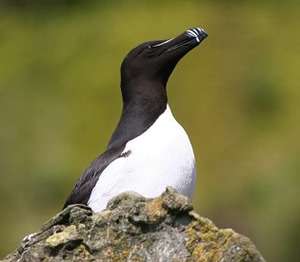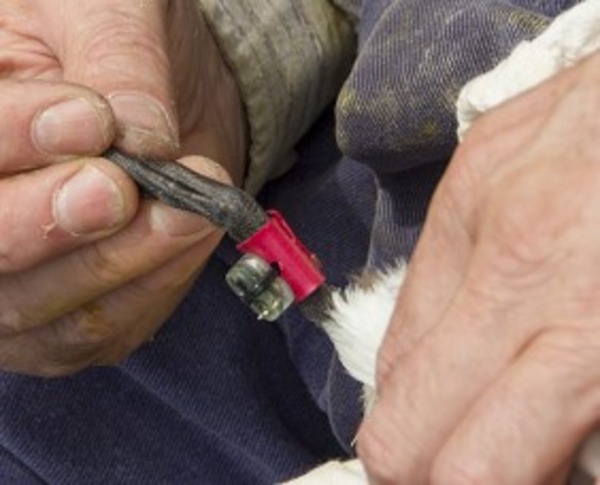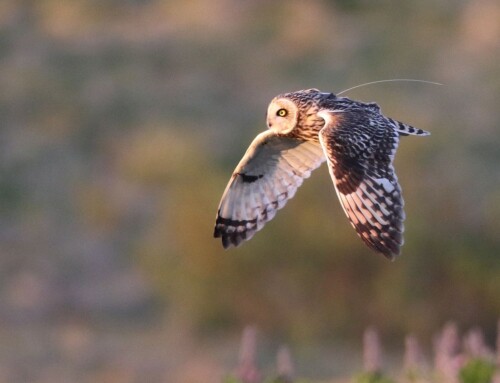 LINKED PAPER
LINKED PAPER
Interspecific variation in non-breeding aggregation: a multi-colony tracking study of two sympatric seabirds. Buckingham, L., Bogdanova, M.I., Green, J.A., Dunn, R.E., Wanless, S., Bennett, S., Bevan, R.M., Call, A., Canham, M., Corse, C.J., Harris, M.P., Heward, C.J., Jardine, D.C., Lennon, J., Parnaby, D., Redfern, C.P.F., Scott, L., Swann, R.L., Ward, R.M., Weston, E.D., Furness, R.W. & Daunt, F. 2022 Marine Ecology Progress Series. doi: 10.3354/meps13960 VIEW
The UK Government plans a five-fold increase in offshore wind farms in UK waters by 2030. However, the UK has internationally important populations of seabirds with many of the largest colonies protected under the Birds Directive. Surveys have shown that Guillemots (Uria aalge) and Razorbills (Alca torda) tend to avoid offshore wind farms. This avoidance represents a loss of feeding habitat for these birds. In addition, Guillemots and Razorbills may fly around offshore wind farms rather than taking the most direct route through areas with wind turbines.
Predicted mortality of Guillemots and Razorbills resulting from displacement and barrier effects caused by offshore wind farms is of concern. However, in the absence of reliable evidence, predictions are based on precautionary “worst case” scenarios. The intended five-fold increase in generating capacity could thus be greatly assisted by improving our understanding of the actual impacts of offshore wind farms and which populations are affected. It is therefore essential to understand the seasonal movements of Guillemots and Razorbills that breed at different colonies.

Figure 1 Guillemot carrying sandeel to feed its chick.
We can get an indication of seasonal movements from ringing studies. Large numbers of Guillemots and Razorbills have been ringed at colonies around Britain and Ireland, but ring-recovery rates are low. In addition, ringed birds tend to be recovered if they die near places where people are likely to find them. Ringing recoveries therefore may not give accurate indications of the locations and seasonal movements of healthy birds. Ringing data suggest that adult Guillemots and Razorbills from UK colonies normally stay in UK waters, and although analysis of the ring-recovery data has hinted at possible colony-specific differences in wintering areas, no clear picture has emerged, despite decades of ringing effort.
The development of geolocator tags has provided an alternative way of finding out where adult birds go at different time of the year. Geolocator tags measure light intensity and temperature. Daylength and time of sunrise and sunset allow the bird’s location to be detected, but the accuracy is relatively low. However, this can be improved by comparing the sea-temperature data recorded by the tag with satellite sea-surface temperature maps. Light and temperature data from geolocators provide less-accurate estimates of location than those that could be obtained from GPS tags, but they nevertheless give a broad picture of the distribution of the birds and have the key advantage that they are small enough to be attached to a bird’s ring and left there for a year or more. The battery life and data-storage capacity also allow data to be collected for at least a year and stored until the tag is recovered. Fortunately, Guillemots and Razorbills normally breed at exactly the same nest site each year, are relatively easy to catch, and tolerate being handled.
Funding from Vattenfall’s European Offshore Wind Deployment Centre enabled a coordinated research programme from 2017 to 2022 to deploy geolocators on Guillemots and Razorbills breeding at colonies around the UK. Key to the success of this project was local bird-ringers, working at colonies that they know well to catch the birds, attach the tags, and recover them 1 or 2 years later. Bird welfare was a priority, given that these tags had not previously been used widely on auks; however, there were no signs that the tags had any adverse impacts on the birds’ behaviour.

Figure 2 A geolocator attached to a leg ring on a Razorbill.
Analysis of the results confirmed much of what we thought we knew about the seasonal movements of Guillemots and Razorbills, but also produced some real surprises. Several Guillemots from a variety of colonies, especially in Shetland, travelled all the way to the Barents Sea off north Norway in late summer, apparently just to moult, and then returned to spend the winter in the sea off Scotland, in the same area as the rest of the birds from their colony. This moult migration was unknown from 100 years of ringing Guillemots in Scotland. Interestingly, most male Goosanders (Mergus merganser) from the UK also migrate to north Norway to moult, and it is likely that both species make this journey for the same reason, namely the abundance of sandeels. The high densities of sandeels off north Norway have never been the target of industrial fisheries, and the area thus provides a reliable place for the birds to become flightless and regrow new flight feathers with access to abundant food.
Although only 2% of tagged birds made this long-distance moult migration, the fact that they did so is particularly interesting in the context of possible barrier effects of offshore wind farms on Guillemot mortality. If Guillemots can make a round-trip of about 4,000 km from Scotland to the Barents Sea just to moult, it seems unlikely that having to fly a few extra kilometres around an offshore wind farm would reduce their body condition enough to increase their risk of death.
The geolocator data clearly show that Guillemots breeding in different colonies also spend the winter in different areas at sea. However, the colony-specific wintering areas seen in Guillemots are much less evident in Razorbills. The geolocator data indicated that Razorbills from many colonies, including colonies in the west of Scotland, aggregated in the northern North Sea in winter. The geolocator data also showed that surprisingly few of the adult birds tracked from UK study colonies wintered in the southern North Sea. However, we know that large numbers of Guillemots and Razorbills occur in the southern North Sea in winter, so where do they come from? Perhaps they are mostly immature birds rather than adults? This is an important unresolved question, given the high concentration of offshore wind farms in the southern North Sea, not only in UK waters, but also off Germany, the Netherlands and Belgium.
This research programme highlights the enormous benefit to be gained from the expertise of local ringers, who can work with researchers using industry funding to fill key knowledge gaps. This collaboration has greatly improved our understanding of the seasonal movements of Guillemots and Razorbills breeding in UK colonies, and this information will in turn inform the assessment of the risks posed by offshore wind developments to particular populations of these birds.
References
Dunn, R.E., Wanless, S., Daunt, F., Harris, M.P. and Green, J.A. 2016. A year in the life of a North Atlantic seabird: behavioural and energetic adjustments during the annual cycle. Scientific Reports 10: 5993. VIEW
Peschko, V., Mercker, M. and Garthe, S. 2020. Telemetry reveals strong effects of offshore wind farms on behaviour and habitat use of common Guillemots (Uria aalge) during the breeding season. Marine Biology 167: 118 VIEW
Image credit
Top right: Razorbill © Bob Furness.
If you want to write about your research in #theBOUblog, then please see here.




